|
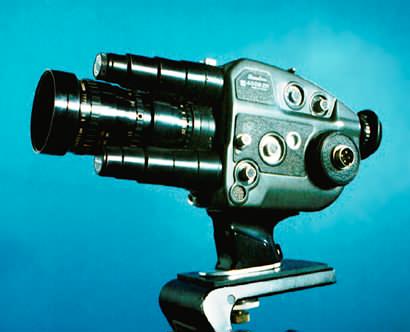

The telescopic C-mount lens in the picture
directly below is NOT included in this auction. Click
here to see more.
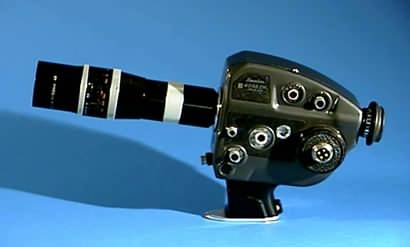
Click pictures below for enlargements
  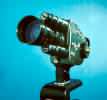
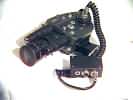 
Power!
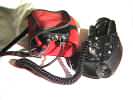 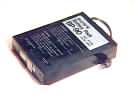 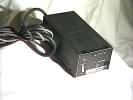
Click pictures above for enlargements
These last three images, just above, show how I set up my
camera's power for remote shooting. The red belt/shoulder
bag holds the Sony BP-90 Ni-Cad Battery and a custom dual-voltage
reglator. The final picture shows a compatable Sony battery
charger with power supply. Just guessing, this might power
through 100 rolls of film and give one lots of time for zooming
and adjusting for perfection.
This camera package is being sold with the
following items:
- One Beaulieu 4008 ZM camera (Serial Number 881566) with
Angenieux f:1.9 Zoom Lens focal length 8 to 64mm and lens
cap
- Original Instruction Manual
- Original Sales Brochure
- Custom Dual Voltage regulator with coiled power cable
and camera adapter plug ready to accept battery power.
- Original Beaulieu charger that came with the camera
when new.
Camera Condition
Condition of the camera is generally pretty
good. It has worked well for my purposes.
The camera has been used a lot since its birth
and shows signs of its age, general wear, such as a few chips
on the paint of the lens side (as seen in the close up photo).
The paint on the body is pretty nice, worn a little thin in
a few spots, with a few small nicks here and there. The leatherette
material is still in place and looks good. The viewfinder
rubber cup is still together, but will eventually need replacement.
This is still a very impressive machine. (Please examine the
photos.)
The manual recommends lubrication of the camera
by factory trained technician every 3 years. This has not
been done since I have owned it, but it has spent considerable
time in storage during its 9 years in my possession.
The power zoom on the factory Angenieux lens
works well, makes a little sound when set to highest zoom
speed. This is common. I just tried a friend's lens and it
sounded identical.
The reglomatic system which drives the aperture
on the factory Beaulieu lens when in automatic mode has never
functioned properly since my ownership of the camera. Apparently
this is an extremely common occurrence on older Beaulieu models,
and fortunately not of much consequence. The manual adjustment
works fine and is the superior method of setting exposure
for all professional applications. Also, manual mode is the
only way to set exposure on most C-mount lenses.
Reglomatic system "Quotes" below
from famed Beaulieu expert: Martin W. Baumgarten
"As these cameras age, it is quite common
for the metering system to begin to lose accuracy, the galvanometer
(meter needle) to become inactive, and for the automatic reglomatic
system which drives the lens aperture to become sluggish and/or
not work properly."
MANUAL MODE
"It is often best to use the camera in manual mode anyhow,
just as you would any professional camera. It also has a tendency
to vary the exposure somewhat when set to automatic or manual
when in non-running mode as compared to when it's in operation.
This is due to the guillotine shutter interfering with the
meter reading, and cutting down some of the light the meter
receives."
"Also, try to avoid using the camera in automatic when
shooting any slower than normal speed, since the shutter system
will severely begin to affect the auto-exposure mode."
More:
"The light meters weren't all that great on automatic
even when these cameras were new...
but worked fine in manual mode."
"And manual mode is how most Beaulieu older model owners
use their cameras anyhow....
and usually with a handheld light meter (unless the built-in
one is still functioning well)."
"In closing, I would like to add that the BEAULIEU Super
8mm movie cameras are quite capable machines, and will deliver
some of the sharpest and steadiest Super 8mm footage you have
ever seen."
|
Beaulieu 4008 ZM Super 8 Movie Camera
Although this page looks similar to my Ebay ad, it has expanded
information and links that most Beaulieu fans would appreciate..
Free:
Download the original 4008 ZM sales brochure
Another
Gift 4 U: Instruction manual for operation of a 4008 ZMII
Somebody so nicely scanned and placed on the web. This is
almost identical to the 4008 ZM manual which is provided with
my camera. Unfortunately, you must download and save each
page individually. This document is available this week only!
Go
to: Capturing The Past Movie Making Page
See:
Super Long Lens on this Camera
See:
My current Multisensory Projects and Inventions
In response to a question about speed limits for recording
Super 8
As I understand it, 70 fps is about the limit for Super 8.
I have shot at that speed with great success. BTW: I used
to have a movie miniatures company. What are you shooting
that requires slow motion? Water in a pool, needing to look
like big slow moving waves? This camera does single frame
animation of course.
One book I have says that nobody besides Beaulieu has dared
go beyond 54 frames per second.
Lenny Lipton, a film and camera expert, in his book "The
super 8 book" has these comments based upon his own tests.
"At the extreme slow-motion end, 70 fps, which I suppose
could be called ultra slow motion for a super 8 cartridge-loading
camera, things aren't so good. Nobody else has dared to go
beyond 54 fps, I think, because of the convoluted path the
film travels through the cartridge. The extra drag on the
film, designers must have reasoned, would cause too much tension
and unsteadiness."
He goes on to say:
"At 70 fps, I suspect this is exactly what is happening
in the Beaulieu. It isn't very steady. You will probably find
that the registration is acceptable for many slow motion subjects.
None of the people who looked at my footage thought it was
unsteady, but I did."
"I think this is one of the world's most finely manufactured
cameras."
It's time that I sadly depart with my favorite
super 8 film camera…. my precious Beaulieu 4008ZM. Its
been sitting on my shelf too long, and I need the money to
help finance my current project.
I purchased this fine camera used, in 1996, from a camera
dealer in Santa Cruz, CA and used it for special film projects
and effects. At that time, I owned a video production company,
and had requirements that video cameras and most small film
cameras lacked.
If you are reading this, then you probably know this camera
and its features already. If not, or if you want to learn
more, I have place the complete original sales brochure online
for you to download, albeit one page at a time.

Click the orange
picture above to download the original sales brochure.
Advantages of this camera that are important
to me:
Film Type and Film Speed: The
ASA could be set at levels way beyond commercial super-8 film
available at the time. I often purchased the latest professional
negative film stock, for transfer to video for later editing.
Contrast ratios and resolution are superb compared to video
and we could pick up elements out of the shadows during transfer
when we chose, almost like getting to shoot it a second time.
Speed, Fast and Slow Motion: I
made particular uses of this camera's ability to shoot wonderful
slow motion sequences, as it is capable of firing off anything
between 2 fps up to 70 fps (frames per second).
In my case, shooting a waterfall at 70 fps, played back at
the normal 18 or 24 fps, you could see every splash and droplet
flying through the air in beautiful dreamy motion, something
a digital video camera, with all is bells and so-called high-tech
whistles cannot duplicate with such natural smoothness. Another
time I filmed my daughter doing cartwheels, and had a beautiful
record of every body movement, again not possible without
film (Some may try, very expensively, to simulate this with
between frame animation).
Lens Choices and Availability: I
have used this camera with various C-mount lenses (See my
Beaulieu information site) When using these alternate C-mount
lenses, the camera is normally set to manual, and all settings
can be done manually while viewing through the internal lens
meter, or better yet, with an hand held light meter, the professional
way.
Accuracy: Other uses were for
special legal situations, where precise lighting reproduction,
contrast ratios and coloring of critical scenery were required.
The best video cameras had previously failed. This camera
filmed all accurately and successfully.
Custom Voltage Regulator and Battery
The original battery was long expired when I purchased the
camera. Small and expensive, the original battery puts out
two separate voltages at the same time to the camera. Rather
that purchase another with its limited power, I chose to assemble
a special dual voltage regulator, one that would permit use
of an my external rechargeable battery packs, battery belts,
and even a car battery to power the camera. A machine shop
carefully removed the lid of the old battery for me, which
I modified to accept a power cable. I used a 12-volt battery
most of the time, but anything above 7.2 Volts and possibly
up to 24 should work. I kept the regulator in a small pack
with my new larger battery.
Click pic for enlargement 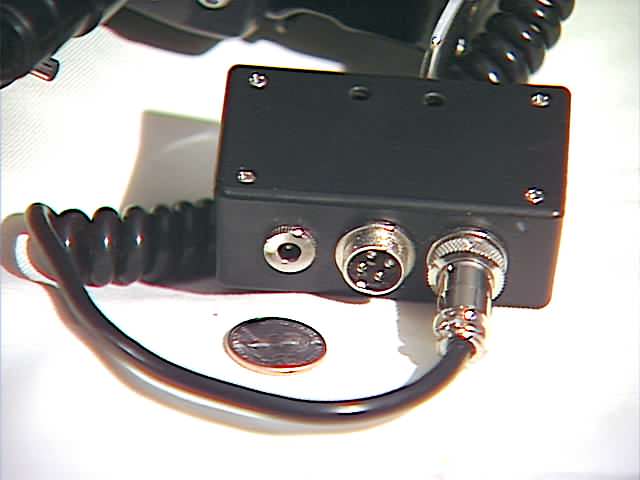
I am keeping my current battery, as it powers other video
equipment still in my use. A rechargeable battery from Radio
Shack for running remote control cars 9.6 volts with a charger
is available for about $29.00 that would offer much more power
than the original.
Battery & Power "Quotes" below from famed
Beaulieu expert: Martin W. Baumgarten
"However, there is nothing wrong with the original battery
pack, provided you have a new one, one in good condition,
or have an older one re-celled as new. The limitation is that
a fully charged original Beaulieu 4008 battery pack will only
power approximately 5 to 8 cartridges, depending on which
running speed you're using, if you turn off the power frequently
when not using the camera, and how much you use the power
zoom feature."
"So from this you can see, that it is very handy to
have an additional, or even several battery packs. Since they
are quite expensive (about $150 to $190 each), you could easily
pay more for just three battery packs than what you can buy
the entire camera for! One solution is to use a battery belt
set or larger external power source fed to the camera via
the external power cord and the dummy battery socket (which
replaces the NiCad battery in the camera's side)."
"Alternatively, you can also make up your own power
supply, if you are knowledgeable enough... since you don't
want to damage the delicate light metering system."
"The camera operates on two voltages,
-- one to feed the power zoom and drive motor (at full 7.2volts),
-- and another to power the light metering system (approximately
4volts)."
"Many have used video camera 7.2volt battery packs and
made up their own power supply.... by still using the dummy
battery socket and external power cord, and splicing the feed
end of the power cord to the two different voltages (you have
to operate on the video battery pack to run a line out for
the lesser light metering voltage)."
"Some have just tied in the 7.2 volts to power the motor
and zoom only, and just left the metering system alone (especially
if it's not working correctly anyhow, common on some very
old 4008s), and used manual metering with a good hand-held
light meter etc."
Please read this all carefully and inspect the photos before
bidding.
Good Luck!
|